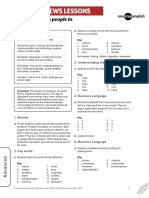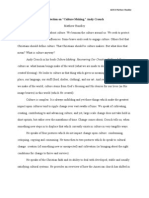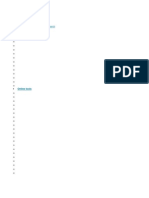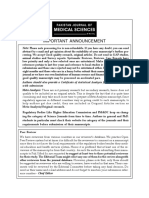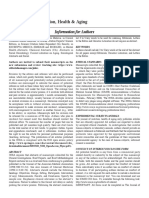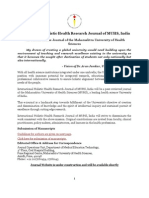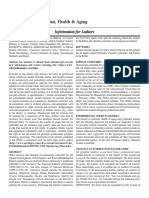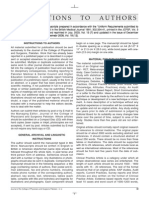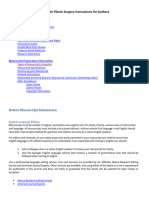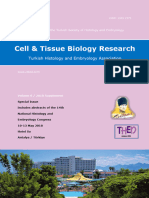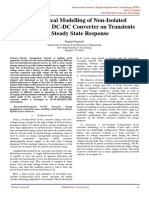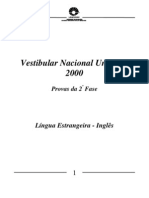Guidance
Guidance
Uploaded by
Farshid GheisariCopyright:
Available Formats
Guidance
Guidance
Uploaded by
Farshid GheisariCopyright
Available Formats
Share this document
Did you find this document useful?
Is this content inappropriate?
Copyright:
Available Formats
Guidance
Guidance
Uploaded by
Farshid GheisariCopyright:
Available Formats
Guidance for Authors on the Preparation and Submission of Manuscripts to the Journal of Gastrointestinal and Liver Diseases*
Scope
The Journal of Gastrointestinal and Liver Diseases (formerly Romanian Journal of Gastroenterology) publishes papers reporting original clinical and scientic research, which are of a high standard and which contribute to the advancement of knowledge in the eld of gastroenterology and hepatology. The eld comprises prevention, diagnosis and management of gastrointestinal and hepatobiliary disorders, as well as related molecular genetics, pathophysiology, and epidemiology. The journal also publishes reviews and editorials on those specic topics. Case reports will be accepted if of great interest and well investigated. Technical Reports and Clinical Imaging chapters should include new or improved techniques and devices used in clinical research or in the practice of gastroenterology, and hepatology. Letters to the Editor, especially those mentioning an opinion on an article previously published, or expressing a new nding are welcome. Letters are selected for their importance and not all letters submitted can be publised. Notes will also be accepted if on topics of professional interest. The website address of the Journal of Gastrointestinal and Liver Diseases is http://www.jgld.ro The journal is published quarterly and papers are accepted for publication in English language. Papers from contributors living abroad and from Romanian authors should be addressed to the editorial ofce: Prof. Monica Acalovschi, Editor Journal of Gastrointestinal and Liver Diseases 3rd Medical Clinic, Str.Croitorilor no.19-23 400162 Cluj-Napoca, Romania. Tel./Fax: +40-264-433335. E-mail: editorjgld@gmail.com Please consider before submission A covering letter should accompany your submission.
*These instructions comply with those formulated by the International Committee of Medical Journal Editors. The Journal of Gastrointestinal and Liver Diseases is on the list of journals that follow the ICMJEs Uniform Requirements for Manuscripts Submitted to Biomedical Journals. The list as well as the complete document can be found at: http://www.icmje.org.
You can use your own wording, but please consider the following points and make the appropriate declarations. Redundant or duplicate publication We ask you to conrm that your paper has not been published in its current form or a substantially similar form (in print or electronically, including on a website), that it has not been accepted for publication by another journal, and that it is not under consideration by another publication. The International Committee of Medical Journal Editors has provided details regarding duplicate or redundant publications (http://www.icmje.org). In your covering letter to the editors, please mention any published work that concerns the same patients or subjects as the present paper. Conicts of interest Authors are asked to state all possible conicts of interest, including nancial and other relationships. If you are sure that there is no conict of interest, please state this also. The sources of funding should be acknowledged in your paper. Permissions to reproduce previously published material Please send us copies of permission to reproduce material (such as illustrations) from the copyright holder. Patients consent forms The protection of a patients right to privacy is essential. Please send copies of patients consent forms on which patients or other subjects of your experiments clearly grant permission for the publication of photographs or other material that might identify them. If the consent form for your research does not specically include this, please obtain it or remove the identifying material. Even if patient-identifying material is not included in your paper, all studies dealing with patients or normal volunteers (including case reports) need their written informed consent. A statement must be included in the Methods section of your paper. Ethics Committee approval You must state clearly in your submission in the Methods section that you conducted studies on human participants with the approval of the Hospital, or University Ethics
Guidance for Authors
115
Committee etc. Similarly, you must conrm that experiments involving animals adhered to ethical standards. Authorship We ask that all authors sign the submission letter. It has happened that someone named as an author has not been aware of the submission of a paper and, on occasion, has not supported the ndings published or the manuscript form. We therefore ask all authors to conrm that they have read and approved the paper. We also ask all authors to conrm that they have met the criteria for authorship as established by the International Committee of Medical Journal Editors, believe that the paper represents honest work, and are able to verify the validity of the results reported. Copyright assignment Papers are accepted for publication on the understanding that exclusive copyright in the paper is assigned to the Publisher. Authors are asked to sign a copyright assignment form after acceptance of their papers. They may use material from their paper in other works published by themselves. Submissions All manuscripts submitted to the Journal of Gastrointestinal and Liver Diseases are made available for online review. The journal introduced the electronic submission of manuscripts in Word format (see Online manuscript submission), but also accepts manuscripts submitted as attachments to electronic mail (text, gures and tables). Do not send them in PDF format. The word count for electronic submissions is up to 3,500 words for original articles, 1,500 words for case reports, 2,000 for Clinical Imaging papers, 500 words for Letters, and 4,500 words for review articles. Authors should NOT in addition post a hard copy submission to the editorial ofce, unless they are supplying artwork, letters or les that cannot be submitted electronically, or have been instructed to do so by the editorial ofce. Include the following where appropriate: subject consent forms; transfer of copyright form; permission to reproduce previously published material; checklist. For those authors who have no option but to submit by mail please send one copy of the article, plus an electronic version on disk or CD-ROM to the Editorial Ofce, Journal of Gastrointestinal and Liver Diseases, 3rd Medical Clinic, Str. Croitorilor no.19-23, 400162 Cluj-Napoca, Romania. Double spacing should be used throughout the manuscript, which should include the following sections, each starting on a separate page: title page, abstract and key words, text, acknowledgements, references, individual tables and legend for gures. Pages should be numbered consecutively, beginning with the title page, and the Arabic numbers should be placed in the top right hand corner of each page.
which should be so identied and should comprise up to 45 characters). The rst name, middle initial and last name of each author should appear. If the work is to be attributed to a department or institution, its full name should be included. Any disclaimers should appear on the title page, as should the name and address of the author responsible for correspondence concerning the manuscript and the name, address and e-mail address of the author to whom requests for reprints should be made (the author should mention if he does not want his e-mail address to be published). A word count for the text only (excluding abstract, acknowledgement, gure legends, and references) allows editors and reviewers to assess whether the information contained in the paper warrants the amount of space devoted to it, and whether the submitted manuscript ts within the journals word limits. A separate word count for the Abstract is also useful for the same reason. Finally, the title page should include the sources of any support for the work in the form of grants, equipment, drugs, or any combination of these. Abstracts The second page should carry a structured abstract of no more than 250 words. Do not use abbreviations, footnotes, or references. Background & Aims. Describe the importance of the study and the precise research objective(s) or study question(s). Methods. Methods should include information on the following aspects of study design when applicable: Design - describe the basic study design, e.g. randomized controlled trial, cross sectional study, cohort study, case series, survey etc; Setting - specify whether the study was conducted in a primary or tertiary care setting, in an ambulatory care clinic or hospital, in the general community etc; Participants - indicate the number of study subjects and how they were selected, recruited, and assigned to the intervention; Intervention - report the method of administration and duration of the intervention. Results. Provide the main outcomes of the study, including condence intervals or p values. Conclusion. State only conclusions that are directly supported by the evidence and the implications of the ndings. Review articles and case reports should include an unstructured summary. Key words The abstract should be followed by a list of 310 keywords or short phrases which will assist the cross-indexing of the article and which may be published. When possible, the terms used should be from the Medical Subject Headings list of Index Medicus (http://www.nlm.nih.gov/mesh/ meshhome.html). Text Full papers of an original study may be divided into sections headed Introduction, Methods (including ethical and
Presentation of papers
Title page The title page should carry the full title of the paper and a short title to be used as a short running head (and
116
statistical information), Results and Discussion (including a conclusion). This so-called IMRAD structure is not simply an arbitrary publication format, but rather a direct reection of the process of scientic discovery. Long articles may require subheadings within some sections (especially the Results and Discussion sections) to clarify their content. Other types of articles, such as case reports, reviews, and editorials, are likely to require other formats. Excessive use of abbreviations is not recommended. Outline statistical methods used. Identify drugs and chemicals used by generic name (if trade-marks are mentioned, manufactured name and city should be given). Acknowledgements Acknowledgements should be made only to those who have made a substantial contribution to the study. Authors are responsible for obtaining written permission from people acknowledged by name in case readers infer their endorsement of data and conclusions. References References should be numbered consecutively in the order in which they rst appear in the text. They should be assigned Arabic numerals, which should be given in brackets, e.g. [12]. References should include the names of all authors when six or fewer; when seven or more, list only the rst three names and add et al. References should also include full title and source information. Journal names should be abbreviated as in Index Medicus (http://www.nlm.nih.gov/ tsd/serials/terms_cond.html). No more than 90-100 references will be accepted for reviews. For Letters to the Editor, 5-6 references. References should be typed double-spaced on separate sheet. Abbreviations of journals conform to those used in Index Medicus. Examples: Articles Nomura H, Sou S, Tanimoto H et al. Short-term interferon therapy for acute hepatitis C: a randomized controlled trial. Hepatology 2004; 39: 1213-1219. Gould JC, Melvin WS. Telerobotic foregut and esophageal surgery. Surg Clin North Am 2003; 83: 1421 1427. Book Whitehead WE, Schuster MM, Gastrointestinal Disorders. Behavioral and Physiological Basis for Treatment. Orlando: Academic Press, 1985. Chapter in books Kahrilas PJ, Pandolno JE. Gastroesophageal reux disease and its complications, including Barretts metaplasia. In: Sleisenger and Fordtrans Gastrointestinal and Liver Diseases. 7th Edn, Philadelphia: Saunders, 2002, 599-622. Avoid or keep as low as possible the use of abstracts as references. Personal communications and unpublished work should not feature in the reference list but should appear in parentheses in the text. Unpublished work accepted for publication but not yet released should be included in the reference list with the words in press in parentheses beside the name of the journal concerned. References must
be veried by the author(s) against the original documents, although JGLD also checks the accuracy of the references. Tables Each table should be typed on a separate sheet in double spacing. Tables should not be submitted as photographs. Each table should be assigned a Roman numeral (e.g. Table III) and a brief title. Explanatory matter should be placed in footnotes. Explain in footnotes all non-standard abbreviations that are used in each table. Identify statistical measures of variations, such as standard deviation and standard error of the mean. Each table should be cited in the text. Illustrations All graphs, photographs (on glossy paper), diagrams will be referred to as figures and should be numbered consecutively in the text in Arabic numerals. They will be submitted in copy actual-size and on diskettes or CD-rom and electronically as a separate electronic le, preferably named as gure 1.tiff, gure 2.jpeg etc., whenever possible. Do not prepare too small images, as there is no effective way to increase the resolution of an image beyond its original size. Figures must be at least 150 dpi to ensure quality. If scanned, line art should be at a resolution of 800 dpi, and halftones and colour at 300 dpi. For vector images (graphs, carts), eps is the best format to be used. If a figure has been published before, the original source must be acknowledged and written permission from the copyright holder for both print and electronic formats should be submitted with the material. Permission is required regardless of authorship or publisher. Figures may be reduced, cropped or deleted at the discretion of the Editor. Figures that are submitted in color must be published for color reproduction costs. Send fax written agreement for color reproduction costs to (+40-264-433335), email to editorjgld@gmail.com or includ with submission. Legends for illustrations Captions should be typed in double spacing, beginning on a separate page. Each one should have an Arabic numeral corresponding to the illustration to which it refers with a title above and explanatory notes below it. Do not embed image les or other objects in your Word document. Internal scales should be explained and staining methods for photomicrographs should be identied. Units of measurement Measurements of length, height, weight, and volume should be reported in metric units (meter, kilogram, or litre) or their decimal multiples. Temperatures should be given in degrees Celsius. Blood pressures should be given in mmHg. All hematological and clinical chemistry measurements should be reported in the metric system in terms of the International System of Units (SI). Editors may request that alternative or non-SI units be added by the authors before publication.
Guidance for Authors
117
Abbreviations and symbols Use only standard abbreviations. Avoid abbreviations in the title and abstract. The full term for which an abbreviation stands should precede its rst use in the text unless it is a standard unit of measurement. Pre-submission checklist It is hoped that this list will be useful during the nal checking of an article prior to sending it to the Journals Editor for review: one author designated as corresponding author: with e-mail address, full postal address, telephone and fax numbers; all necessary les have been uploaded; keywords, running head; all gures and tables (including title, description, foot-notes); references are in the correct format for this Journal; all references mentioned in the reference list are cited in the text, and vice versa; permission has been obtained for use of copyrighted material from other sources. Reprints Ten reprints of the published articles and a copy of the Journal will be supplied free of charge. If required in a greater number, they will be available on payment of the necessary cost.
manuscript, please contact us at the address: editorjgld@gmail.com By implementing this online system, we ensure greater speed and accuracy in publishing. We thank all of you for your willingness to work with us in making important information even more accessible and timely.
Editorial policy
We welcome all contributions in the eld of gastroenterology and hepatology. We invite known personalities with expertise and many published papers in a specic eld to write reviews and editorials in our journal. We accept original papers and case reports from all countries, including Eastern Europe, Africa and Asia in order to promote the performances of the authors from emerging countries. We do not accept any more papers related to pediatric pathology. We also do not publish experimental studies. The Journal of Gastrointestinal and Liver Diseases offers thorough peer review, online submission and immediate publication on acceptance. The journal is advised by an International Editorial Board, and a local Review Board. The Editor-in-chief or one of the local editors rst reads the manuscripts received and in about 1-3 weeks decides upon their priority level: some are immediately sent to the reviewers, some are rejected without being sent for review and some are returned to authors with suggestions for improvement before submitting them to reviewers. In this case, the Editor-in-chief rst reads the revised manuscript, and if adequate changes have been made, he sends it to the reviewer. All manuscripts are checked before printing by the English language Editor. Peer-review procedure The Journal of Gastrointestinal and Liver Diseases promotes evaluation of all the original papers by two or three independent reviewers, of whom two are international personalities. The peer-review process is essential for ensuring the quality of the scientific information disseminated. Authors are invited to suggest two or three possible reviewers from the respective eld of interest and, if they consider necessary, to mention whom they do not want to review their paper. The reviewers are asked to evaluate the manuscript by applying the same standards as for the international journals. The reviewers send their comments to the Editor. The Editor will inform the authors about the suggestions made by the referee and ask them to answer the questions and make the required corrections. This information is provided up to three months from the date they submitted the paper to the journal. The revised manuscript should be sent in no more than two months to the Editor. Revised manuscripts sent later will not be considered. When the Editor receives the corrected version with all changes marked, accompanied by a letter with a point-bypoint reply to the reviewers comments, he sends those back to the same reviewer, who makes the nal recommendation for acceptance or rejection of the manuscript.
Online manuscript submission
The process is simple. Go to www.jgld.ro, click on Guidelines for authors and read the guidelines. Then, back on the home page of www.jgld.ro, go to Submit an article and click. The rst time you use the system, you will register for an account. You will use your account log-in and password each time you return to the site, whether to make changes in your manuscript (edit) or check on the status of your submitted manuscript (check status). After you log on, click on Add new article and start to submit the manuscript (Edit article) title, authors, abstract, text, gures and tables, in the order required. Once you begin the submission process, the red rectangles indicate that you need to take an action on the selected task. Your text and gures will be uploaded in a few minutes and you will rst save the manuscript. Then you will see it again and check for corrections. You click on Submit and your manuscript will be submitted. You are once more asked and you should conrm submission. Once in our system, the manuscript is assigned a tracking number and you will receive a conrmation letter. When the reviewers will approve to evaluate your manuscript, it will appear as under evaluation when you check the status. As soon as the reviewers comments are ready, you will receive a letter from the editor conrming acceptance, inviting you to revise your manuscript, or informing you that the manuscript can not be accepted for publication. If you encounter any problem when submitting your
118
Open access The abstract of the published articles will immediately be placed in PubMed Central. Thanks to the Open Access policy of the Journal of Gastrointestinal and Liver Diseases, all original articles, reviews, editorials and case reports published in the journal are available online for all to read
and use free of charge. Free and unrestricted availability via the Internet to all increases the visibility of your paper and may result in higher rate of citation. The Editorial Team J Gastrointestin Liver Dis
CORRECTION
The Editor appologizes for the following errors which appeared in the Journal of Gastrointestinal and Liver Diseases: In Volume 18, Number 4, December 2009, the authors of the Letter to the Editor Splenic marginal zone lymphoma in a patient with chronic hepatitis B infection should have been stated as Leonidas Christou1, Georgios Kalambokis1, Maria Bai2, Sevasti Kamina2, Epameinondas V. Tsianos1. 1) 1st Division of Internal Medicine; 2) Department of Pathology; University Hospital, Ioannina, Greece. On Medline, the authors should appear as Christou L, Kalambakis G, Bai M, Kamina S, Tsianos EV. On account of a typographical error, only the name of the last author, E.V. Tsianos, was published. In Volume 17, Number 4, December 2008, the name of one of the authors of the paper Improving nonalcoholic fatty liver disease management by general practitioners: a critical evaluation and impact of an educational training program should be G. DAmbrosio instead of G. DAmbrozio.
Medical University Press Cluj-Napoca, Romania Cover design: Istvn Feleki Front cover image: Low-power photomicrograph of the polypectomy specimen with variable-sized, abnormal submucosal spaces with intact overlying mucosa. Jeong Wook Kim et al. Fig. 3, p. 86 ISSN: 1841 8724 Printed by TIPOOFFSET CLUJ Director: Alpr Piricsi
You might also like
- MCCQE CollectionDocument103 pagesMCCQE Collectionleo_toronto100% (10)
- Credit Repair Letter To Send After Debt DischargeDocument6 pagesCredit Repair Letter To Send After Debt Dischargeamenelbey82% (11)
- Business News Lessons: Memes Motivate People To Engage and ActDocument2 pagesBusiness News Lessons: Memes Motivate People To Engage and ActMaria TowersNo ratings yet
- Matthew Hundley Book Reflection "Culture Making" Andy CrouchDocument2 pagesMatthew Hundley Book Reflection "Culture Making" Andy CrouchMatthew HundleyNo ratings yet
- 9h The Flowers Annotation and Analysis ExerciseDocument2 pages9h The Flowers Annotation and Analysis Exerciseapi-263744910No ratings yet
- Literature and SocietyDocument28 pagesLiterature and SocietyAyomikun Oluwafemi Idowu100% (1)
- 360 NormasDocument12 pages360 NormasAliNo ratings yet
- BJA Submission GuidelinesDocument28 pagesBJA Submission GuidelinesJayNo ratings yet
- Submission Preparation ChecklistDocument7 pagesSubmission Preparation ChecklistCitra Ayu ApriliaNo ratings yet
- AH-InstructionsToAuthors Annals of HerpatologyDocument4 pagesAH-InstructionsToAuthors Annals of HerpatologyAndresPimentelAlvarezNo ratings yet
- Instructions To The Authors: About JournalDocument13 pagesInstructions To The Authors: About JournalReena ChhabadaNo ratings yet
- BjomsDocument11 pagesBjomsSagar JangamNo ratings yet
- Guide For Authors: Aims and ScopeDocument11 pagesGuide For Authors: Aims and ScopeYodi SoebadiNo ratings yet
- Submission Preparation Checklist: Guideline For AuthorDocument11 pagesSubmission Preparation Checklist: Guideline For AuthorRizka HanifahNo ratings yet
- Authors6 22Document7 pagesAuthors6 22MUHAMMAD ARSLAN YASIN SUKHERANo ratings yet
- InstructionsDocument8 pagesInstructionsherry novrindaNo ratings yet
- Oct2021 - IA JNHADocument2 pagesOct2021 - IA JNHACristian RamosNo ratings yet
- CCLM - Information For AuthorsDocument9 pagesCCLM - Information For AuthorsLuis Bonino SanchezNo ratings yet
- Guide for authorsDocument14 pagesGuide for authorsChristian Reza WibowoNo ratings yet
- Instructions To Authors-IJVSDocument9 pagesInstructions To Authors-IJVStibaNo ratings yet
- 464 - Surgical Endoscopy - Submission Guidelines 082023Document23 pages464 - Surgical Endoscopy - Submission Guidelines 082023alihumoodhasanNo ratings yet
- Instructions To The AuthorsDocument9 pagesInstructions To The AuthorsAnonymous LtCXRONo ratings yet
- Journal Announcement Guidelines 300712Document19 pagesJournal Announcement Guidelines 300712Shital KiranNo ratings yet
- For Author: Aims and ScopeDocument5 pagesFor Author: Aims and ScopeNaga RajanNo ratings yet
- Instructions To AuthorsDocument4 pagesInstructions To AuthorsBlich high School0% (1)
- JNIM Author Submission ChecklistDocument2 pagesJNIM Author Submission ChecklistDwi Adi NugrohoNo ratings yet
- IJID - Author InformationDocument21 pagesIJID - Author InformationvitiaNo ratings yet
- Author Jurnal JermanDocument6 pagesAuthor Jurnal JermanRinny ArdinaNo ratings yet
- Otolaryngology-Head and Neck Surgery: Author GuidelinesDocument5 pagesOtolaryngology-Head and Neck Surgery: Author GuidelinesdarsunaddictedNo ratings yet
- Critérios para Revista JoacsDocument4 pagesCritérios para Revista JoacsDayse_sbNo ratings yet
- Instructions For Authors 26-04-2022Document10 pagesInstructions For Authors 26-04-2022Stefan StevanovicNo ratings yet
- JCPSP - Journal of College of Physicians and Surgeons PakistanDocument6 pagesJCPSP - Journal of College of Physicians and Surgeons PakistanMUHAMMAD ARSLAN YASIN SUKHERANo ratings yet
- JIB - Instructions For AuthorsDocument5 pagesJIB - Instructions For AuthorsIhsanul AriefNo ratings yet
- ElsevierDocument14 pagesElsevierDrDevdatt Laxman PitaleNo ratings yet
- Journal of The American Oil Chemists' Society: Instructions To AuthorsDocument4 pagesJournal of The American Oil Chemists' Society: Instructions To AuthorsHoracio GorosteguiNo ratings yet
- Al Ameen Journal ManuscriptDocument5 pagesAl Ameen Journal ManuscriptshreyasNo ratings yet
- NZVJ Checklist For Submissions 2010 0Document1 pageNZVJ Checklist For Submissions 2010 0mfmalikNo ratings yet
- JNHA - Dec2020Document3 pagesJNHA - Dec2020ARDO SANJAYANo ratings yet
- Author Guidelines: Human and Animal RightsDocument5 pagesAuthor Guidelines: Human and Animal RightsSyahdat NurkholiqNo ratings yet
- Instructions To Authours PDFDocument4 pagesInstructions To Authours PDFSiva PrasadNo ratings yet
- Instructions To Authors 24 6 22Document7 pagesInstructions To Authors 24 6 22Hanna KarolinaNo ratings yet
- Author Guidline. CPSPDocument4 pagesAuthor Guidline. CPSPMuhammad MoazzamNo ratings yet
- JU_IFADocument4 pagesJU_IFAmaltoubatNo ratings yet
- Instructions For Authors HantheDocument2 pagesInstructions For Authors Hanthebmnn8fbfryNo ratings yet
- Fese Instructions For AuthorsDocument12 pagesFese Instructions For AuthorsYuji EnriquezNo ratings yet
- AjmcDocument10 pagesAjmcRavi UkawalaNo ratings yet
- Instructions 2Document7 pagesInstructions 2Fildzah CyNo ratings yet
- Sports Medicine 2023Document4 pagesSports Medicine 2023huiducalexandraNo ratings yet
- Scientific Augustinians Aims and ScopeDocument8 pagesScientific Augustinians Aims and ScopeDax BelasotoNo ratings yet
- ZAHRA Journal of Health and Medical Research (Translated) .EditedDocument15 pagesZAHRA Journal of Health and Medical Research (Translated) .EditedLukman Nur HakimNo ratings yet
- Ajodo Author GuidelinesDocument16 pagesAjodo Author Guidelinessakmak2010No ratings yet
- Instructions To Authors: Download ACP FormDocument9 pagesInstructions To Authors: Download ACP FormMansoor TariqNo ratings yet
- IJPSN Author InstructionsDocument4 pagesIJPSN Author InstructionsVenkatesh Gavini0% (1)
- Ophthalmology Are Summarized Below. Before Sending A Manuscript Contributors Are RequestedDocument8 pagesOphthalmology Are Summarized Below. Before Sending A Manuscript Contributors Are RequestediAdrivNo ratings yet
- SPER Publications and Solutions Pvt. LTDDocument8 pagesSPER Publications and Solutions Pvt. LTDSony Eka NugrahaNo ratings yet
- New Phytologist Author GuidelinesDocument14 pagesNew Phytologist Author GuidelinesmnkjhpNo ratings yet
- APS Instructions For AuthorsDocument13 pagesAPS Instructions For Authorsdoctorshomare1No ratings yet
- Clin Rad Irnstructions - Authors - CRDocument5 pagesClin Rad Irnstructions - Authors - CRdermoNo ratings yet
- Guide For Authors BradevDocument5 pagesGuide For Authors BradevHanu Krishnan S KNo ratings yet
- General: Pharmaceutical Statistics Is An Industry-Led Initiative, Tackling Real Problems in StatisticalDocument12 pagesGeneral: Pharmaceutical Statistics Is An Industry-Led Initiative, Tackling Real Problems in Statisticalmuhammad sandyNo ratings yet
- Cell & Tissue Biology Research (PDFDrive)Document341 pagesCell & Tissue Biology Research (PDFDrive)kanchan151010No ratings yet
- Author Guidelines IejDocument15 pagesAuthor Guidelines IejNamish BatraNo ratings yet
- Volume 8 Number 2Document73 pagesVolume 8 Number 2Shazwani KKTSNo ratings yet
- Instructions For Authors: General RequirementsDocument4 pagesInstructions For Authors: General RequirementsVatsal ChhayaNo ratings yet
- Ejd EthicsstatementDocument2 pagesEjd EthicsstatementAlexandru Codrin-IonutNo ratings yet
- On Prolonging Human LifeDocument12 pagesOn Prolonging Human LifeFarshid GheisariNo ratings yet
- v1 ThomsonDocument59 pagesv1 ThomsonFarshid GheisariNo ratings yet
- Behavior and Ethics QuestionsDocument26 pagesBehavior and Ethics QuestionsRahul VadlapatlaNo ratings yet
- 2 Marks With AnswersDocument10 pages2 Marks With Answersdupr2002No ratings yet
- Hypothesis and Assumptions of The StudyDocument9 pagesHypothesis and Assumptions of The StudyHael Leigh0% (1)
- Credit Transactions - Transcribed First LectureDocument5 pagesCredit Transactions - Transcribed First LectureClarisse Ann MirandaNo ratings yet
- SkullDocument2 pagesSkullfarish_machya100% (1)
- Contract ID No. 23GF0020 - Detailed EstimateDocument7 pagesContract ID No. 23GF0020 - Detailed EstimateAsia Structural Developer CorpNo ratings yet
- 11100.T01 Assess Engagement Risk (10-28-2021 9.02.55 AM)Document5 pages11100.T01 Assess Engagement Risk (10-28-2021 9.02.55 AM)Mazen MohamedNo ratings yet
- Mathematical Modelling of Non Isolated Bi Directional DC DC Converter On Transients and Steady State Response IJERTCONV3IS20053Document5 pagesMathematical Modelling of Non Isolated Bi Directional DC DC Converter On Transients and Steady State Response IJERTCONV3IS20053CHHEDI LAL MishraNo ratings yet
- Mobile Banking and Internet BankingDocument10 pagesMobile Banking and Internet BankingNeeraj DwivediNo ratings yet
- Admin Law Meaning, Nature, ScopeDocument22 pagesAdmin Law Meaning, Nature, ScopeScheherazade SandhuNo ratings yet
- An Inconvenient Truth Reflection PaperDocument6 pagesAn Inconvenient Truth Reflection PaperGlocel Faith CasugaNo ratings yet
- Experiment 8 Hydraulic JumpDocument8 pagesExperiment 8 Hydraulic JumpOsama RashaydaNo ratings yet
- Cbse Class 6 Ncert Books Math Chapter 1 Knowing Our NumbersDocument27 pagesCbse Class 6 Ncert Books Math Chapter 1 Knowing Our Numbersvijayraman45No ratings yet
- Hydraulic Engineering - Lec - 4 - StudentsDocument15 pagesHydraulic Engineering - Lec - 4 - StudentsUsman Ali0% (1)
- GOPIN, Marc - Between Eden and ArmageddonDocument321 pagesGOPIN, Marc - Between Eden and Armageddonking hirumaNo ratings yet
- Goh Shu Ching - Resume - 2020 - NovartisDocument2 pagesGoh Shu Ching - Resume - 2020 - NovartisSouseiseki ChromeNo ratings yet
- Corporate BrochureDocument86 pagesCorporate BrochureNikhil JainNo ratings yet
- Saum (Fasting) Class LectureDocument8 pagesSaum (Fasting) Class LecturePaper CutNo ratings yet
- Analytical AssignmentDocument23 pagesAnalytical AssignmentTashey ChhodyenNo ratings yet
- Art and Pain in Frida Kahlo PDFDocument6 pagesArt and Pain in Frida Kahlo PDFFábio Kusumi OtsukaNo ratings yet
- InglesDocument7 pagesInglesKauaneyNo ratings yet
- Ispe Baseline Guide v5 Commissioning and Qualification 2nd Ed 2019 PDF 2 PDF Free 5Document1 pageIspe Baseline Guide v5 Commissioning and Qualification 2nd Ed 2019 PDF 2 PDF Free 5asilveyraNo ratings yet
- Exam Ucsp FinalDocument5 pagesExam Ucsp Finalraquel mercadoNo ratings yet
- Barbic Zamuner 2020 - Ijerph-17-07836 POTS WAIDocument15 pagesBarbic Zamuner 2020 - Ijerph-17-07836 POTS WAIbetozam3No ratings yet
- Hydroelectric Power Plant: Layout, Working and TypesDocument4 pagesHydroelectric Power Plant: Layout, Working and Typesprerna raiNo ratings yet
- 12 Key Principles On Bhava AnalysisDocument28 pages12 Key Principles On Bhava AnalysisDhinesh100% (2)


